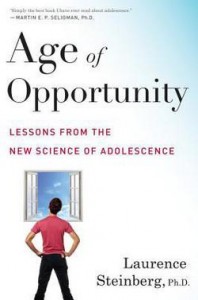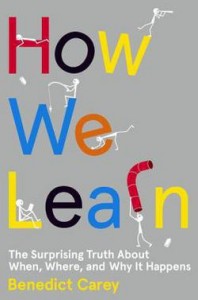What the New Research Tells Us About Adolescence and Learning | Professional Shelf
Does cramming for exams work? Are there benefits to testing? What type of projects encourage deeper understanding? New research in brain and cognitive science offers insights into adolescent behavior and learning with significant implications for both students and teachers.
 In 2013, President Obama introduced the BRAIN Initiative, a long-term research investment focused on the development of neurotechnologies to better understand how the brain works. While there’s still much to discover, brain and cognitive science already offer insights into learning and behavior that have significant implications for students and teachers. In Age of Opportunity: Lessons from the New Science of Adolescence (HMH, 2014), developmental psychologist and researcher Laurence Steinberg asks readers to consider how we perceive and respond to adolescents and their behavior. As he outlines a rather long list of concerns, including academic underachievement, substance abuse, teenage pregnancy, violent behavior, and mental health problems, it's clear that new approaches are worth considering. Defining adolescence as lasting from ages 10 to 25, Steinberg reviews the biological and cultural changes that have contributed to the lengthening of this developmental phase. He also explains that adolescence is “a period of heightened brain plasticity.” So, while adolescents might appear physically mature, their brains are still developing. On the bright side, a longer adolescence allows for more time to explore interests and develop self-regulation, one of the brain’s most important executive functions and predictors of future well-being. But it also means a longer period in which young adults are drawn to potentially risky, reward-seeking behavior. The consequences of this are far-reaching, especially for adolescents from socioeconomic groups that don’t have social and academic advantages afforded by a high family income. In addition, the author takes a close look at the juvenile justice system and how knowledge of brain science can foster fairer treatment. Steinberg has good advice for anyone living or working with adolescents, prompting us all to be proactive, to support social programs and schools that encourage healthy adolescent development rather than trying to fix problems after damage has been done. While Steinberg isn’t the first to advocate taking a fresh look (see Daniel J. Siegel’s Brainstorm (Tarcher/Penguin, 2013), and Paul Tough’s How Children Succeed (HMH, 2012), his careful research and analysis is a welcome addition to a much needed discussion.
In 2013, President Obama introduced the BRAIN Initiative, a long-term research investment focused on the development of neurotechnologies to better understand how the brain works. While there’s still much to discover, brain and cognitive science already offer insights into learning and behavior that have significant implications for students and teachers. In Age of Opportunity: Lessons from the New Science of Adolescence (HMH, 2014), developmental psychologist and researcher Laurence Steinberg asks readers to consider how we perceive and respond to adolescents and their behavior. As he outlines a rather long list of concerns, including academic underachievement, substance abuse, teenage pregnancy, violent behavior, and mental health problems, it's clear that new approaches are worth considering. Defining adolescence as lasting from ages 10 to 25, Steinberg reviews the biological and cultural changes that have contributed to the lengthening of this developmental phase. He also explains that adolescence is “a period of heightened brain plasticity.” So, while adolescents might appear physically mature, their brains are still developing. On the bright side, a longer adolescence allows for more time to explore interests and develop self-regulation, one of the brain’s most important executive functions and predictors of future well-being. But it also means a longer period in which young adults are drawn to potentially risky, reward-seeking behavior. The consequences of this are far-reaching, especially for adolescents from socioeconomic groups that don’t have social and academic advantages afforded by a high family income. In addition, the author takes a close look at the juvenile justice system and how knowledge of brain science can foster fairer treatment. Steinberg has good advice for anyone living or working with adolescents, prompting us all to be proactive, to support social programs and schools that encourage healthy adolescent development rather than trying to fix problems after damage has been done. While Steinberg isn’t the first to advocate taking a fresh look (see Daniel J. Siegel’s Brainstorm (Tarcher/Penguin, 2013), and Paul Tough’s How Children Succeed (HMH, 2012), his careful research and analysis is a welcome addition to a much needed discussion.  Delving into the science of learning and memory, journalist Benedict Carey questions some long-held assumptions about the best ways to study, retain information, and deepen understanding. In How We Learn: The Surprising Truth About When, Where, and Why It Happens (Random House, 2014), the author begins with his own story. Despite being an academic "grind," Carey wasn't accepted to any of his first choice colleges. Instead, he "begged" admittance to the University of Colorado where he eventually relaxed and really started to learn. So what happened? As Carey sifts through the research, he uncovers some surprising answers. The book begins with an overview of how the brain works. Part two addresses how and when to study—cramming works but knowledge is better retained when study time is spread over days. And testing has its benefits, since extra effort at retrieving information strengthens our hold on it. In the third section, the author focuses on the research on comprehension and critical insight, which suggests that distractions aren’t necessarily a bad thing since taking a break when we’re stuck helps. Ideas need time to “percolate,” so longer school projects could encourage deeper understanding. Finally, Carey explains the roles played by the subconscious and sleep (naps aid retention). An appendix of “Eleven Essential Questions” highlights his overall findings which are relevant for learners of any age and can help “make learning more a part of living and less an isolated chore.”
Delving into the science of learning and memory, journalist Benedict Carey questions some long-held assumptions about the best ways to study, retain information, and deepen understanding. In How We Learn: The Surprising Truth About When, Where, and Why It Happens (Random House, 2014), the author begins with his own story. Despite being an academic "grind," Carey wasn't accepted to any of his first choice colleges. Instead, he "begged" admittance to the University of Colorado where he eventually relaxed and really started to learn. So what happened? As Carey sifts through the research, he uncovers some surprising answers. The book begins with an overview of how the brain works. Part two addresses how and when to study—cramming works but knowledge is better retained when study time is spread over days. And testing has its benefits, since extra effort at retrieving information strengthens our hold on it. In the third section, the author focuses on the research on comprehension and critical insight, which suggests that distractions aren’t necessarily a bad thing since taking a break when we’re stuck helps. Ideas need time to “percolate,” so longer school projects could encourage deeper understanding. Finally, Carey explains the roles played by the subconscious and sleep (naps aid retention). An appendix of “Eleven Essential Questions” highlights his overall findings which are relevant for learners of any age and can help “make learning more a part of living and less an isolated chore.” Add Comment :-
RELATED
RECOMMENDED
CAREERS
The job outlook in 2030: Librarians will be in demand
CAREERS
The job outlook in 2030: Librarians will be in demand
ALREADY A SUBSCRIBER? LOG IN
We are currently offering this content for free. Sign up now to activate your personal profile, where you can save articles for future viewing





